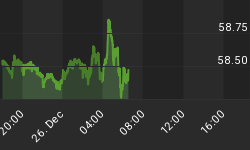The "dumb money" or investment sentiment composite indicator (see figure 1, a weekly chart of the S&P500) looks for extremes in the data from 4 different groups of investors who historically have been wrong on the market: 1) Investor Intelligence; 2) Market Vane; 3) American Association of Individual Investors; and 4) the put call ratio. The indicator is now in neutral territory. Typically, when this sentiment indicator is at bearish extremes (i.e., bull signal), gains in the stock market occur at an accelerated pace as those on the sidelines chase prices higher. For example, on a closing basis the S&P500 has gained about 10% over the last 3 weeks of time while sentiment was bearish. With sentiment now being neutral, the pace of gains (momentum) should begin to flatten out.
Figure 1. "Dumb Money"
The "smart money" (see figure 2) refers to those investors and traders who make their living in the markets. Supposedly they are in the know, and we should follow their every move. The "smart money" indicator is a composite of the following data: 1) public to specialist short ratio; 2) specialist short to total short ratio; 3) SP100 option traders. The "smart money" remains bearish on equities, and in fact, this is the first time since 1990 (about 45 signals) where the "smart money" did not turn bullish while the "dumb money" was bearish. Over the past 18 years, the "smart money" has always confirmed the unwinding of bearish sentiment as prices move higher. This has not happened yet. In other words, the "smart money" appears not to be buying into this rally yet.
Figure 2. "Smart Money"
In sum, the sentiment picture ("dumb money" plus "smart money") is less supportive of higher prices.















